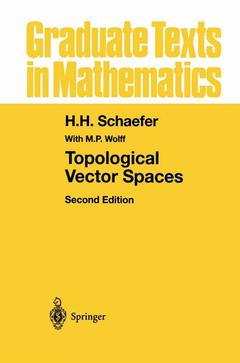Description
Topological Vector Spaces (2nd Ed., 2nd ed. 1999. Softcover reprint of the original 2nd ed. 1999)
Graduate Texts in Mathematics Series, Vol. 3
Author: Schaefer H.H.
Language: English
Subject for Topological Vector Spaces:
Keywords
C-algebra; Compact space; approximation property; compactness; metrizable
Topological Vector Spaces (2nd Ed.)
Publication date: 09-2012
349 p. · 15.5x23.5 cm · Paperback
Publication date: 09-2012
349 p. · 15.5x23.5 cm · Paperback
Approximative price 105.49 €
Subject to availability at the publisher.
Add to cart
Topological vector spaces (2nd ed' 99) (Graduate texts in mathematics, 3)
Publication date: 06-1999
349 p. · 15.5x23.5 cm · Hardback
Publication date: 06-1999
349 p. · 15.5x23.5 cm · Hardback
Description
/li>Contents
/li>
The present book is intended to be a systematic text on topological vector spaces and presupposes familiarity with the elements of general topology and linear algebra. The author has found it unnecessary to rederive these results, since they are equally basic for many other areas of mathematics, and every beginning graduate student is likely to have made their acquaintance. Simi larly, the elementary facts on Hilbert and Banach spaces are widely known and are not discussed in detail in this book, which is :plainly addressed to those readers who have attained and wish to get beyond the introductory level. The book has its origin in courses given by the author at Washington State University, the University of Michigan, and the University of Ttibingen in the years 1958-1963. At that time there existed no reasonably ccmplete text on topological vector spaces in English, and there seemed to be a genuine need for a book on this subject. This situation changed in 1963 with the appearance of the book by Kelley, Namioka et al. [1] which, through its many elegant proofs, has had some influence on the final draft of this manuscript. Yet the two books appear to be sufficiently different in spirit and subject matter to justify the publication of this manuscript; in particular, the present book includes a discussion of topological tensor products, nuclear spaces, ordered topological vector spaces, and an appendix on positive operators.
Prerequisites.- A. Sets and Order.- B. General Topology.- C. Linear Algebra.- I. Topological Vector Spaces.- 1 Vector Space Topologies.- 2 Product Spaces, Subspaces, Direct Sums, Quotient Spaces.- 3 Topological Vector Spaces of Finite Dimension.- 4 Linear Manifolds and Hyperplanes.- 5 Bounded Sets.- 6 Metrizability.- 7 Complexification.- Exercises.- II. Locally Convex Topological Vector Spaces.- 1 Convex Sets and Semi-Norms.- 2 Normed and Normable Spaces.- 3 The Hahn-Banach Theorem.- 4 Locally Convex Spaces.- 5 Projective Topologies.- 6 Inductive Topologies.- 7 Barreled Spaces.- 8 Bornological Spaces.- 9 Separation of Convex Sets.- 10 Compact Convex Sets.- Exercises.- III. Linear Mappings.- 1 Continuous Linear Maps and Topological Homomorphisms.- 2 Banach’s Homomorphism Theorem.- 3 Spaces of Linear Mappings.- 4 Equicontinuity. The Principle of Uniform Boundedness and the Banach-Steinhaus Theorem.- 5 Bilinear Mappings.- 6 Topological Tensor Products.- 7 Nuclear Mappings and Spaces.- 8 Examples of Nuclear Spaces.- 9 The Approximation Property. Compact Maps.- Exercises.- IV. Duality.- 1 Dual Systems and Weak Topologies.- 2 Elementary Properties of Adjoint Maps.- 3 Locally Convex Topologies Consistent with a Given Duality.The Mackey-Arens Theorem.- 4 Duality of Projective and Inductive Topologies.- 5 Strong Dual of a Locally Convex Space. Bidual. Reflexive Spaces.- 6 Dual Characterization of Completeness. Metrizable Spaces. Theorems of Grothendieck, Banach-Dieudonné, and Krein-Šmulian.- 7 Adjoints of Closed Linear Mappings.- 8 The General Open Mapping and Closed Graph Theorems.- 9 Tensor Products and Nuclear Spaces.- 10 Nuclear Spaces and Absolute Summability.- 11 Weak Compactness. Theorems of Eberlein and Krein.- Exercises.- V. Order Structures.- 1 Ordered VectorSpaces over the Real Field.- 2 Ordered Vector Spaces over the Complex Field.- 3 Duality of Convex Cones.- 4 Ordered Topological Vector Spaces.- 5 Positive Linear Forms and Mappings.- 6 The Order Topology.- 7 Topological Vector Lattices.- 8 Continuous Functions on a Compact Space. Theorems of Stone-Weierstrass and Kakutani.- Exercises.- VI. C*—and W*—Algebras.- 1 Preliminaries.- 2 C*-Algebras.The Gelfand Theorem.- 3 Order Structure of a C*-Algebra.- 4 Positive Linear Forms. Representations.- 5 Projections and Extreme Points.- 6 W*-Algebras.- 7 Von Neumann Algebras. Kaplansky’s Density Theorem.- 8 Projections and Types of W*-Algebras.- Exercises.- Appendix. Spectral Properties of Positive Operators.- 1 Elementary Properties of the Resolvent.- 2 Pringsheim’s Theorem and Its Consequences.- 3 The Peripheral Point Spectrum.- Index of Symbols.
© 2024 LAVOISIER S.A.S.

